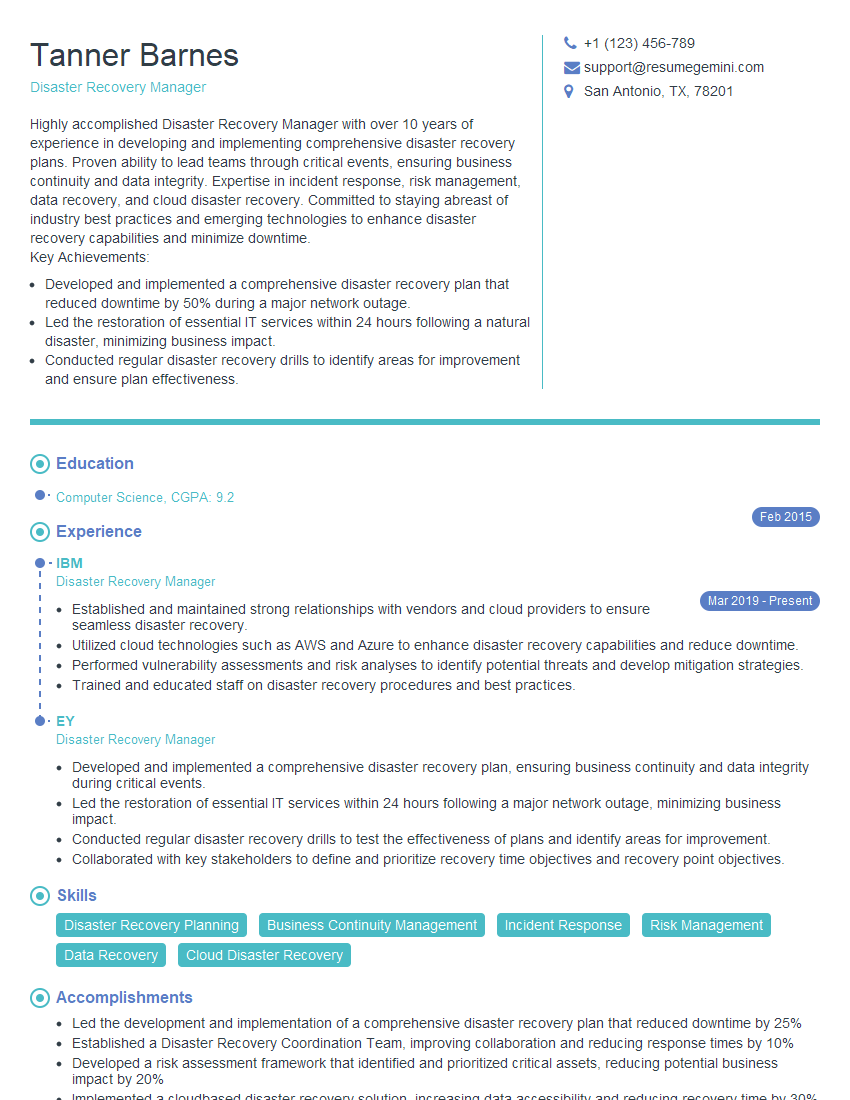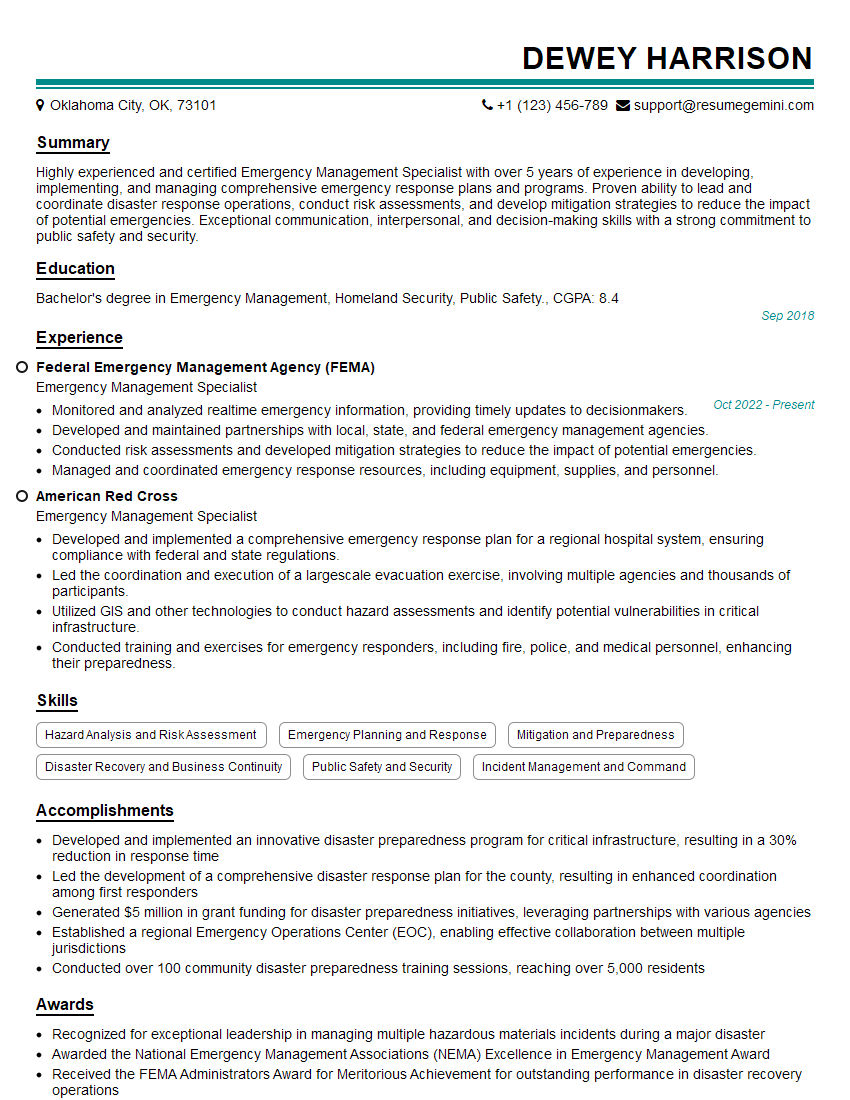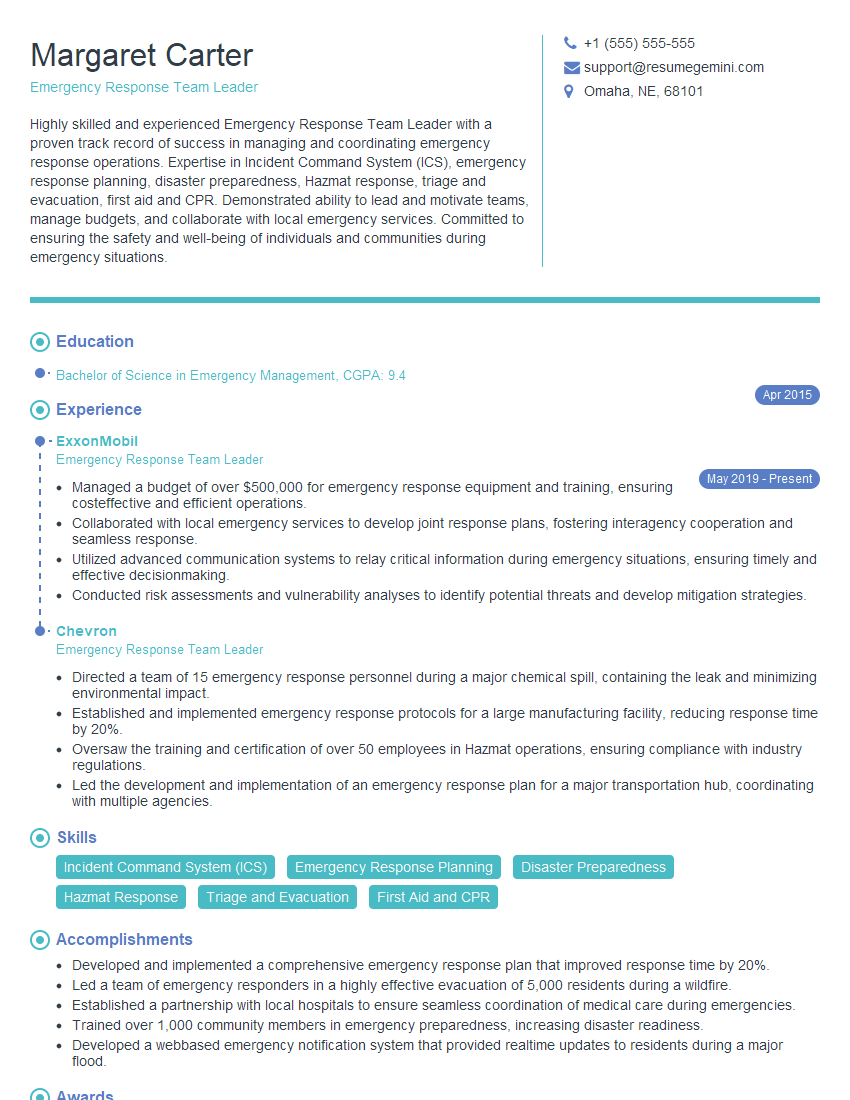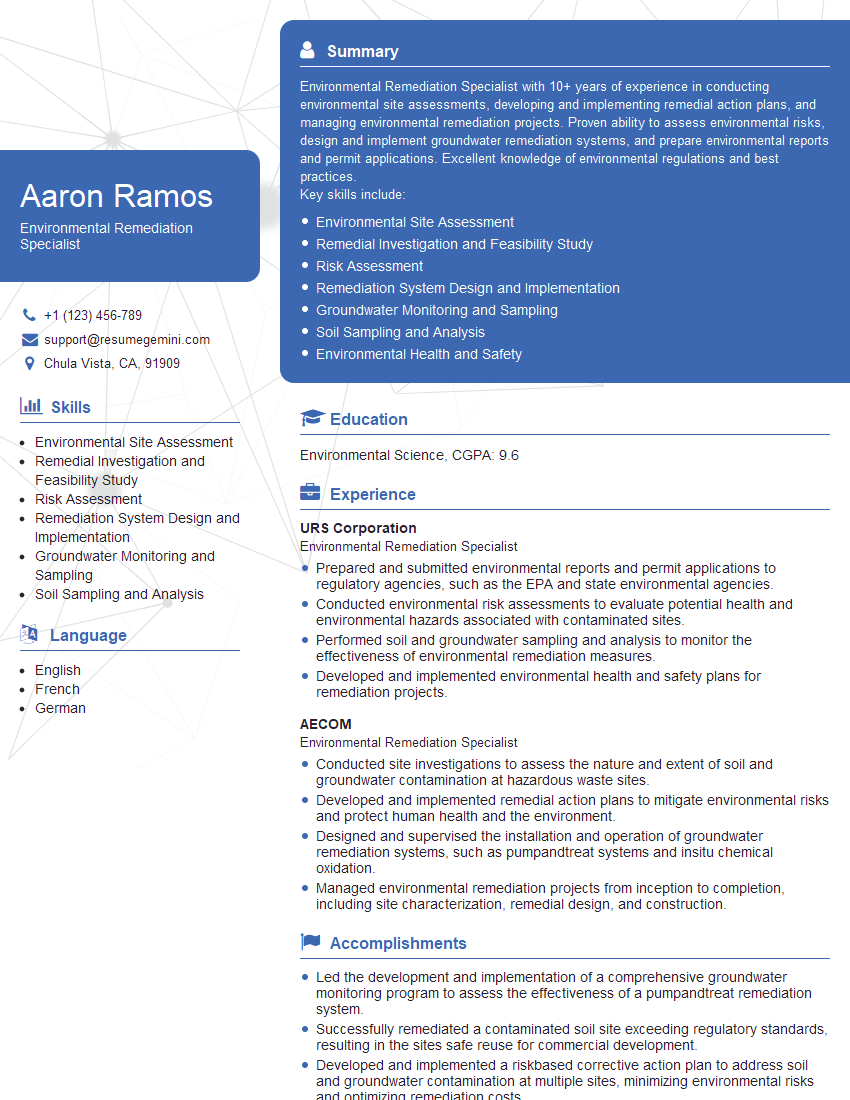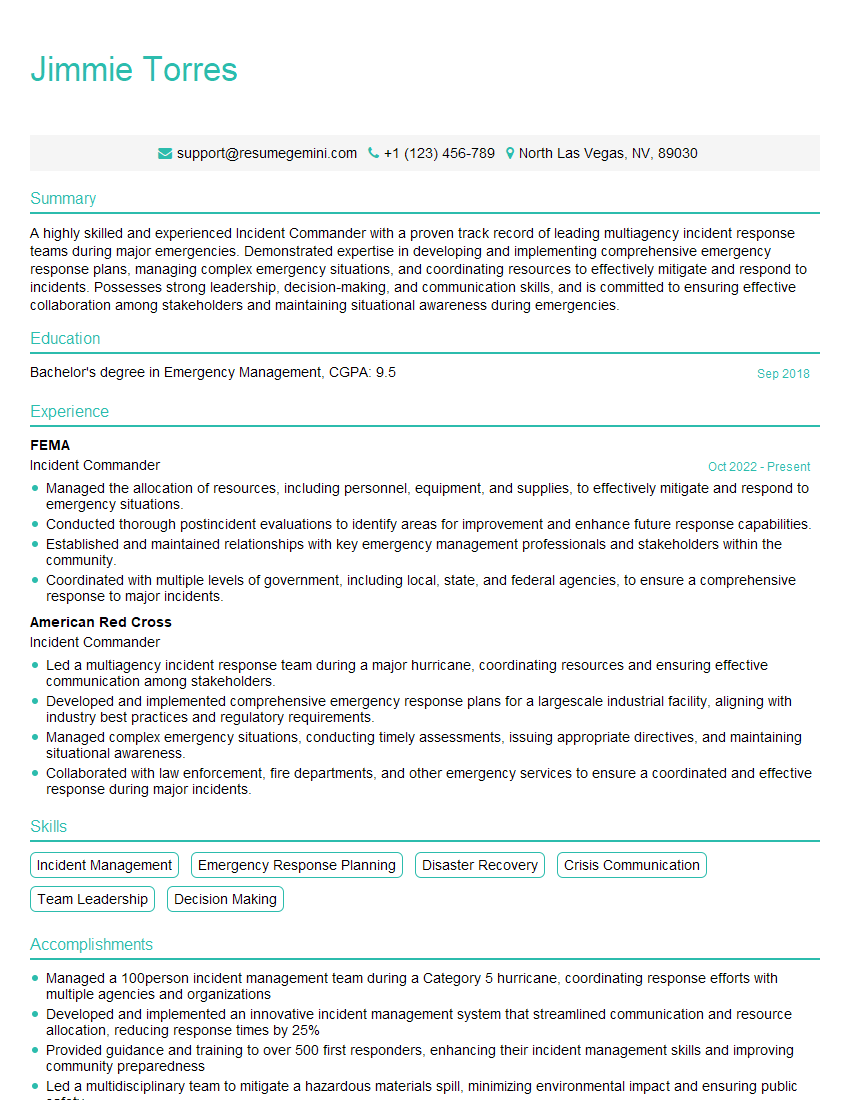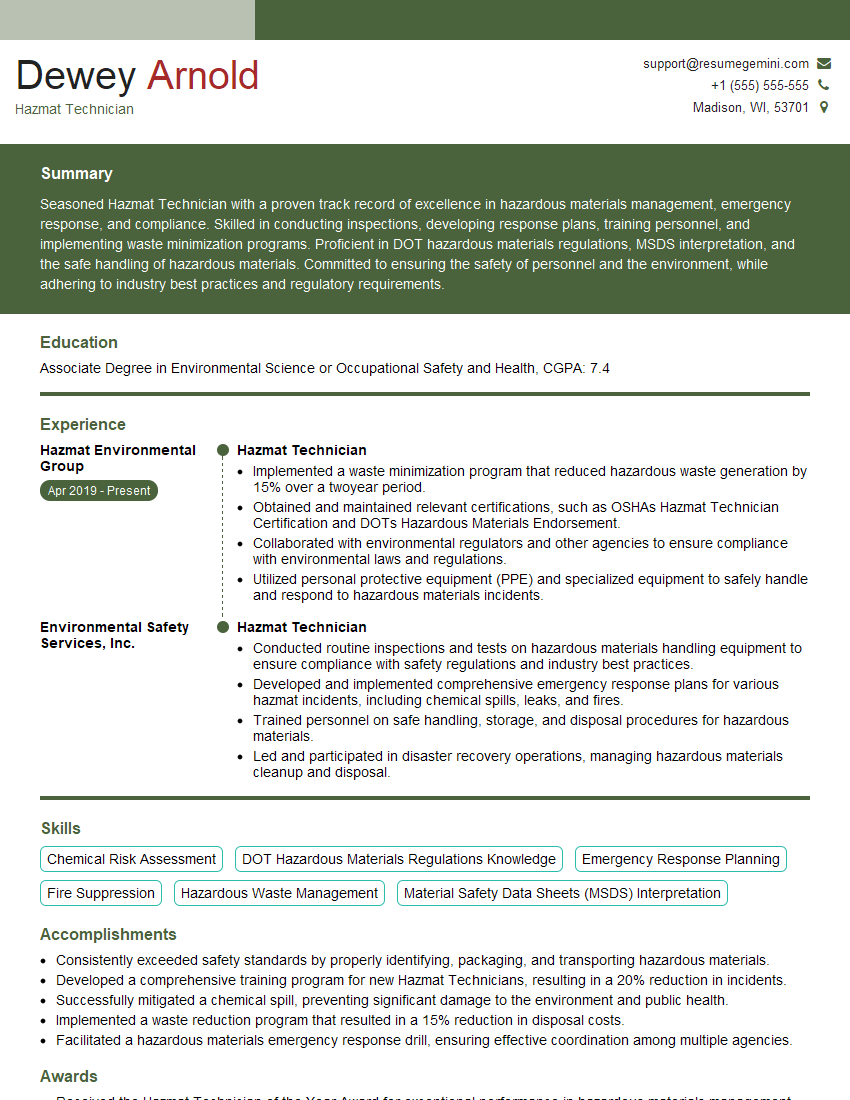The thought of an interview can be nerve-wracking, but the right preparation can make all the difference. Explore this comprehensive guide to Spill Response and Emergency Preparedness interview questions and gain the confidence you need to showcase your abilities and secure the role.
Questions Asked in Spill Response and Emergency Preparedness Interview
Q 1. Describe your experience with developing and implementing SPCC plans.
Developing and implementing Spill Prevention, Control, and Countermeasure (SPCC) plans involves a systematic approach to minimizing the risk of oil spills. My experience spans various industries, from manufacturing to transportation. I’ve led teams in conducting thorough facility assessments to identify potential spill sources, estimating storage capacities, and analyzing potential pathways for spills. This includes evaluating the effectiveness of existing secondary containment, reviewing operational procedures, and identifying training gaps.
For example, I worked with a manufacturing plant to develop an SPCC plan that included the installation of new secondary containment berms around their fuel storage tanks, the implementation of regular inspections and maintenance procedures, and a comprehensive employee training program on spill prevention and response. This resulted in a significant reduction in their risk profile and improved compliance with EPA regulations. Another project involved creating a customized SPCC plan for a trucking company, focusing on vehicle maintenance, driver training on spill prevention, and establishing procedures for reporting and responding to spills during transport.
The process always begins with a thorough site-specific assessment, followed by plan development incorporating engineering controls, administrative controls, and emergency response procedures. Finally, regular plan reviews and updates are crucial to ensure its continued effectiveness.
Q 2. Explain the different types of spills and their associated hazards.
Spills are categorized by the substance involved and their potential hazards. We have chemical spills (acids, solvents, etc.), oil spills (crude oil, petroleum products), and hazardous material spills (toxic substances, flammables, etc.). Each poses unique challenges.
- Chemical Spills: These can cause immediate or delayed health effects depending on the chemical’s toxicity, corrosiveness, or flammability. For instance, a sulfuric acid spill could cause severe burns and environmental damage.
- Oil Spills: These contaminate water bodies, harming marine life and potentially affecting human health through consumption of contaminated seafood. They also cause significant environmental damage due to their persistence in the environment.
- Hazardous Material Spills: This broad category encompasses various substances with potential for explosion, toxicity, or environmental damage. A spill involving cyanide, for example, could be lethal to humans and wildlife.
The associated hazards are often multifaceted, including acute health risks (immediate injury or illness), chronic health risks (long-term health problems), environmental damage (soil and water contamination), and economic losses (cleanup costs, business interruption).
Q 3. What are the key components of an effective emergency response plan?
An effective emergency response plan needs several key components to function smoothly. Think of it as a playbook for a critical situation.
- Pre-incident planning: This includes hazard identification, risk assessment, development of response strategies, training of personnel, and securing necessary equipment.
- Emergency notification: Defining clear communication procedures, including contact lists and notification protocols for relevant authorities (e.g., emergency services, environmental agencies).
- Response procedures: Detailed step-by-step instructions for various spill scenarios, including containment, cleanup, and personnel safety protocols.
- Resource allocation: Identifying and securing necessary resources, such as equipment, personnel, and contractors.
- Post-incident procedures: Steps to follow after the incident, such as investigation, reporting, cleanup verification, and documentation.
- Training and exercises: Regular training and drills are vital to ensure familiarity with the plan and build teamwork.
A well-structured plan minimizes response time, reduces environmental damage, and protects human health. It’s not just a document; it’s a living tool that must be regularly reviewed and updated.
Q 4. How would you prioritize actions during a multi-hazard incident?
Prioritizing actions during a multi-hazard incident requires a systematic approach. I use a framework that prioritizes based on the severity of the immediate threat, potential for escalation, and impact on human health and the environment.
- Immediate Life Safety: This is always the top priority. Addressing immediate threats to human life and providing first aid comes first.
- Containment and Control: The next step is to contain the spread of the hazardous substance to prevent further damage and exposure.
- Environmental Protection: Minimizing environmental impact through containment and cleanup measures.
- Long-term Cleanup: Once immediate threats are addressed, long-term cleanup operations begin to restore the affected area.
- Investigation and Reporting: After the immediate response, a thorough investigation is conducted to determine the cause, assess damages, and report to the relevant authorities.
For instance, in a scenario with a chemical spill causing a fire and endangering workers, the first priority would be to evacuate personnel and extinguish the fire before addressing the spill containment.
Q 5. Detail your experience with containment and cleanup procedures for various substances.
Containment and cleanup procedures are highly substance-specific. My experience covers a wide range of substances.
- Oil Spills: These often involve booms to contain the oil on water, sorbent materials (like pads and booms) to absorb the oil, and vacuum trucks to remove the oil from the sorbents. Specialized equipment like skimmers may be used for larger spills.
- Chemical Spills: The approach depends on the chemical properties. Some might require neutralization, while others might necessitate absorption or dilution. Personal protective equipment (PPE) is paramount to ensure worker safety.
- Hazardous Material Spills: These often require specialized hazmat teams with the appropriate training, equipment, and decontamination procedures. The cleanup process may involve techniques like excavation, washing, or incineration, depending on the substance.
I have hands-on experience in using various containment and cleanup techniques, including the use of specialized equipment, and always adhere to safety protocols and regulatory guidelines. Thorough documentation of all procedures and waste disposal is crucial.
Q 6. What are the legal and regulatory requirements for spill reporting?
Legal and regulatory requirements for spill reporting vary depending on the substance spilled, the quantity, and the location. In the US, the key regulations include the Clean Water Act (CWA), the Comprehensive Environmental Response, Compensation, and Liability Act (CERCLA), and the Resource Conservation and Recovery Act (RCRA).
Reporting thresholds vary; for example, the CWA requires immediate notification to the National Response Center (NRC) for certain oil spills exceeding specific quantities. Similarly, CERCLA has reporting requirements for hazardous substance releases. Failure to comply can lead to significant fines and legal repercussions.
It’s crucial to understand the specific regulations for each substance and location to ensure timely and accurate reporting. This often involves maintaining detailed records of the incident, the actions taken, and the quantities involved.
Q 7. How do you ensure compliance with environmental regulations during spill response?
Ensuring compliance with environmental regulations during spill response involves several key steps.
- Following established protocols: Adhering to the established emergency response plan and all relevant regulations.
- Proper documentation: Maintaining detailed records of all actions taken, including personnel involved, equipment used, and the amount of substance recovered.
- Sampling and analysis: Collecting samples for laboratory analysis to determine the extent of contamination and inform cleanup strategies.
- Waste management: Proper disposal of contaminated materials according to regulations, often requiring specialized disposal facilities.
- Environmental monitoring: Conducting post-spill environmental monitoring to assess the effectiveness of the cleanup and verify that environmental standards have been met.
- Regulatory reporting: Submitting accurate and timely reports to the relevant authorities as required by law.
Continuous monitoring and adherence to best practices ensure environmental protection and legal compliance. Neglecting these steps can result in significant penalties and reputational damage.
Q 8. Describe your experience with personal protective equipment (PPE) selection and use.
Selecting and using the right Personal Protective Equipment (PPE) is paramount in spill response. It’s about choosing the appropriate gear based on the hazardous material involved and the task at hand, ensuring a safe working environment. This involves understanding the hazards – are we dealing with a corrosive chemical, a flammable liquid, or a biological agent? Each requires different PPE.
- Hazard Identification: The first step is a thorough hazard assessment. What are the potential dangers? This might involve consulting Safety Data Sheets (SDS) to understand the properties of the spilled substance.
- PPE Selection: Based on the hazard assessment, appropriate PPE is chosen. This could include:
- Respiratory protection: Respirators, ranging from simple dust masks to self-contained breathing apparatus (SCBA), depending on the toxicity and concentration of airborne contaminants.
- Skin protection: Chemical-resistant suits, gloves (nitrile, neoprene, etc.), boots, and eye protection are crucial to prevent contact with hazardous materials.
- Other protective gear: Hard hats, safety glasses, and high-visibility clothing might also be necessary depending on the situation.
- Training and Fit Testing: Proper training on the use and limitations of the chosen PPE is essential. Fit testing for respirators ensures a proper seal to prevent inhalation of hazardous substances.
- Maintenance and Disposal: PPE needs regular inspection and maintenance to ensure its effectiveness. After use, proper disposal procedures must be followed to prevent further contamination.
For instance, during a chlorine gas leak, SCBA and fully encapsulated suits would be crucial. In contrast, a minor oil spill might only require gloves, boots, and eye protection. The key is a methodical approach that prioritizes safety and effectiveness.
Q 9. What methods do you employ to assess the environmental impact of a spill?
Assessing the environmental impact of a spill is a multi-faceted process that involves several steps to determine the extent of damage and the required remediation. We use a combination of methods to gather data and develop a comprehensive picture.
- On-site assessment: This involves visually inspecting the affected area, noting the type and quantity of spilled material, and identifying the impacted environmental receptors (e.g., soil, water, air, wildlife).
- Sampling and analysis: Soil, water, and air samples are collected from various locations within and around the spill area. Laboratory analysis determines the concentration of contaminants and their potential for spreading.
- Modeling: Sophisticated computer models can predict the spread of contaminants based on factors like wind speed, water currents, and soil properties. This helps in determining the potential extent of the environmental impact.
- Biological assessment: This involves assessing the impact on plant and animal life. This could include surveying the area for dead or affected organisms, conducting water quality tests, or assessing the impact on sensitive ecosystems.
For example, a chemical spill into a river would require water sampling upstream and downstream to determine the extent of contamination and the potential impact on aquatic life. Soil sampling around the spill site would assess the extent of soil contamination, and air sampling would check for volatile organic compounds.
Q 10. Explain your understanding of risk assessment methodologies in emergency preparedness.
Risk assessment is crucial in emergency preparedness. It’s a systematic process to identify potential hazards, analyze their likelihood and consequences, and determine appropriate control measures. Several methodologies exist, including HAZOP (Hazard and Operability Study), FMEA (Failure Mode and Effects Analysis), and qualitative risk matrices.
- Hazard Identification: This stage involves brainstorming all potential hazards related to a specific operation or facility. This could include equipment failures, human error, natural disasters, or external threats.
- Risk Analysis: This involves assessing the likelihood and consequences of each identified hazard. Likelihood refers to the probability of the hazard occurring, while consequences involve the potential impact on people, environment, and property.
- Risk Evaluation: This involves comparing the assessed risks to predefined criteria to determine the level of risk (e.g., low, medium, high). This often involves a risk matrix that plots likelihood against consequences.
- Risk Control: Once risks are evaluated, control measures are implemented to mitigate the risks. This might involve engineering controls (e.g., improved equipment design), administrative controls (e.g., improved procedures), and personal protective equipment (PPE).
For instance, a refinery might conduct a HAZOP study to identify potential hazards during its operations and implement risk mitigation strategies to prevent accidents. A qualitative risk matrix would help prioritize risk control measures based on their severity and probability.
Q 11. Describe your experience with incident command systems (ICS).
Incident Command Systems (ICS) provide a standardized, on-scene, management structure for coordinating emergency response activities. My experience with ICS involves applying its principles to manage various emergency situations, ensuring effective communication, resource allocation, and overall control.
- Command: The overall leader responsible for the incident. They make critical decisions and establish strategic goals.
- Operations: This section manages the tactical operations on the ground, deploying resources and personnel to address the immediate problem.
- Planning: This section collects information, develops strategies, and manages resources for long-term operations.
- Logistics: This section is responsible for procuring, managing, and distributing resources (equipment, supplies, personnel).
- Finance/Administration: Tracks costs, manages documentation, and handles legal and administrative matters.
I’ve used ICS in numerous scenarios, from coordinating a small chemical spill cleanup to managing a large-scale wildfire response. Its modular nature allows for scaling the system based on the complexity and scale of the incident. The clear chain of command and defined roles help avoid confusion and ensure effective teamwork, leading to more efficient and safer outcomes.
Q 12. How do you communicate effectively during an emergency response situation?
Effective communication is critical during emergency response. It involves clear, concise, and timely information exchange among various stakeholders. My approach utilizes multiple channels and considers the audience.
- Clear and Concise Messaging: Using plain language, avoiding jargon, and focusing on key information is essential. This ensures everyone understands the message regardless of their background.
- Multi-Channel Communication: Utilizing various communication tools is crucial for reaching a wide audience. This might include radios, satellite phones, email, and text messaging.
- Regular Updates: Providing consistent and timely updates helps keep everyone informed and minimizes speculation and confusion.
- Feedback Mechanisms: Establishing mechanisms for receiving feedback from field crews and other stakeholders ensures that the communication is effective and relevant.
- Documentation: Maintaining a comprehensive record of all communication helps with accountability and post-incident analysis.
For example, during a hazardous materials spill, I’d use radios for immediate on-site communication, email for coordinating with off-site support teams, and regular press briefings to keep the public informed.
Q 13. What training and certifications do you hold in spill response and emergency preparedness?
My training and certifications reflect a commitment to staying current in the field of spill response and emergency preparedness. I hold certifications in:
- Incident Command System (ICS) – various levels depending on the specific ICS course completed (e.g., ICS 100, 200, 300, 700).
- Hazardous Materials (HazMat) Technician – with specific endorsements relevant to the types of materials I’ve handled (e.g., oil spills, chemical spills).
- National Incident Management System (NIMS) – demonstrating a solid understanding of the national framework for incident management.
- First Aid/CPR/AED – essential for providing immediate medical assistance in emergency situations.
- Other relevant certifications may include those specific to the types of spills I have worked on such as oil spill response or specific hazardous material training.
In addition to formal certifications, I have completed extensive on-the-job training, participating in numerous drills and real-world spill response operations, which have significantly enhanced my practical expertise. Continuous professional development through workshops and conferences is also an integral part of maintaining my competency.
Q 14. Describe your experience with managing resources and personnel during an emergency.
Managing resources and personnel during an emergency requires a systematic approach to ensure effectiveness and safety. This includes planning, delegation, coordination and monitoring.
- Resource Assessment: This involves identifying and evaluating all available resources, including personnel, equipment, supplies, and funding. This assessment informs the development of the response plan.
- Personnel Management: This includes assigning roles and responsibilities based on individual skills and experience, ensuring clear communication channels, and providing necessary training and support.
- Equipment and Supply Management: Ensuring the availability and proper functioning of necessary equipment and sufficient supplies, including PPE, containment materials, and cleanup equipment. Tracking usage and managing inventory are key aspects.
- Coordination and Communication: Maintaining clear communication channels between different teams, agencies, and stakeholders, avoiding duplication of effort, and ensuring efficient resource allocation.
- Monitoring and Evaluation: Continuously monitoring the effectiveness of resource deployment and making adjustments as needed. Post-incident evaluations help improve future response efforts.
For example, during a large-scale oil spill, I’d need to coordinate numerous teams, including cleanup crews, environmental scientists, and support personnel. Effective resource allocation ensures timely and efficient cleanup, minimizing environmental damage.
Q 15. How do you maintain accurate records and documentation during a response?
Maintaining accurate records during a spill response is crucial for legal compliance, insurance claims, and future incident prevention. We employ a multi-pronged approach. Firstly, we utilize a dedicated spill response log, either digital or paper-based, depending on the situation. This log documents every action taken, from the initial notification to the final cleanup. This includes timestamps, personnel involved, equipment used, and the quantities of spilled material recovered. Secondly, we take copious photographs and videos at every stage of the response. This visual record provides invaluable context, especially for demonstrating the extent of the damage and the effectiveness of the cleanup. Finally, all data is meticulously documented in a formal incident report which often includes detailed maps showing the spill’s trajectory, concentration measurements, and affected areas. Think of it like a meticulously kept detective’s notebook – every detail counts. In the case of a large-scale spill, this data will be organized into a dedicated database to ensure efficient management and reporting.
Career Expert Tips:
- Ace those interviews! Prepare effectively by reviewing the Top 50 Most Common Interview Questions on ResumeGemini.
- Navigate your job search with confidence! Explore a wide range of Career Tips on ResumeGemini. Learn about common challenges and recommendations to overcome them.
- Craft the perfect resume! Master the Art of Resume Writing with ResumeGemini’s guide. Showcase your unique qualifications and achievements effectively.
- Don’t miss out on holiday savings! Build your dream resume with ResumeGemini’s ATS optimized templates.
Q 16. What are your strategies for preventing future spills?
Preventing future spills involves a proactive, multi-faceted strategy focusing on hazard identification, risk assessment, and robust control measures. We start with a thorough site assessment to identify potential sources of spills, be it faulty equipment, inadequate storage, or insufficient employee training. Next, we implement a comprehensive risk assessment using methods such as HAZOP (Hazard and Operability Study) or FMEA (Failure Mode and Effects Analysis) to determine the likelihood and severity of potential incidents. This assessment guides the development of preventative measures, which might involve upgrading equipment, implementing improved maintenance schedules, strengthening spill containment systems, and providing enhanced employee training and drills. For example, implementing secondary containment for storage tanks prevents widespread contamination in case of a leak. We also regularly conduct inspections and audits to ensure that preventative measures are effective and that safety protocols are followed. Proactive measures not only minimize the environmental damage but significantly reduce the financial and operational repercussions associated with spill incidents.
Q 17. How do you handle unexpected challenges during a spill response?
Unexpected challenges are inevitable during spill response. Our strategy focuses on adaptability and communication. First, we maintain open communication channels among all response personnel, which can include rapid updates via radio, satellite phone, or messaging systems depending on the location and circumstances. Second, we follow a structured decision-making process that involves evaluating the unexpected challenge, considering the available resources, and adapting our strategy accordingly. For instance, if unexpected weather conditions impede cleanup efforts, we might need to adjust our timeline, bring in additional personnel or equipment, or implement temporary containment measures until conditions improve. This flexible approach is critical, and our team is experienced in navigating unforeseen obstacles, such as difficult terrain, extreme weather, or unanticipated contaminant characteristics. Third, we prioritize safety throughout the process and take prompt action to mitigate any immediate threats. Regular reassessment is critical to ensure we successfully adapt to the situation.
Q 18. Describe your experience with various spill control technologies and equipment.
My experience encompasses a wide range of spill control technologies and equipment. This includes the use of absorbents, such as booms, pads, and pillows, for containing liquid spills on land and water. I’m familiar with various types of booms, from simple sorbent booms to more sophisticated inflatable booms for containing large-scale spills. I have also extensively used specialized equipment such as vacuum trucks for removing liquids, and high-pressure washers for cleaning contaminated surfaces. My experience also includes working with in-situ burning for specific types of flammable spills, however, this technique needs to be carefully evaluated and authorized due to potential environmental implications. For example, when dealing with a chemical spill, understanding the chemical properties of the substance is crucial for selecting the appropriate containment and cleanup methods and personal protective equipment (PPE).
Q 19. Explain your understanding of different remediation techniques.
Remediation techniques depend heavily on the nature of the spilled material and the affected environment. For soil remediation, common techniques include excavation and disposal, bioremediation (using microorganisms to break down contaminants), phytoremediation (using plants to remove or neutralize contaminants), and soil washing. For groundwater remediation, methods such as pump and treat systems, in-situ bioremediation, and permeable reactive barriers are employed. The choice of technique often involves a cost-benefit analysis, considering factors like the extent of contamination, the type of contaminant, and the environmental sensitivity of the area. For example, bioremediation might be a cost-effective and environmentally friendly option for certain types of organic contaminants but is unsuitable for many hazardous substances. Choosing the correct remediation method requires a comprehensive understanding of environmental regulations and best practices.
Q 20. How do you coordinate with external agencies during a large-scale spill?
Coordinating with external agencies during a large-scale spill is essential for efficient and effective response. This typically involves establishing a unified command structure, often with representatives from various agencies such as the Environmental Protection Agency (EPA), local fire departments, state environmental agencies, and potentially, the Coast Guard (for waterborne spills). Clear communication channels are vital, often involving regular briefings, joint decision-making sessions, and the use of common operating procedures. Effective communication tools, such as dedicated radio frequencies or online communication platforms, significantly improve response coordination. Each agency brings specialized expertise and resources; for instance, the EPA provides regulatory oversight, while the fire department handles immediate safety concerns. A well-coordinated effort, ensuring efficient resource allocation and avoiding duplication of efforts, is key to successfully mitigating the impact of a large-scale spill.
Q 21. Describe your experience with post-incident analysis and reporting.
Post-incident analysis and reporting are critical for learning from mistakes, improving future response strategies, and fulfilling legal obligations. This process involves a thorough review of the entire event, from the initial spill to the final cleanup. We gather data from various sources, including the spill response log, photographs, environmental monitoring data, and interviews with involved personnel. This information feeds into a comprehensive report that analyzes the causes of the spill, assesses the effectiveness of the response, identifies areas for improvement, and recommends preventative measures. The report typically includes detailed cost breakdowns, regulatory compliance assessments, and recommendations for preventing similar incidents in the future. This analysis isn’t just about assigning blame; it’s a crucial learning opportunity to refine our response protocols and make sure we are constantly improving our readiness and effectiveness.
Q 22. How do you conduct employee training on spill prevention and response procedures?
Employee training on spill prevention and response is crucial for effective emergency preparedness. Our training program is multifaceted, combining classroom instruction with hands-on practical exercises.
- Classroom sessions: We cover regulatory requirements, the facility’s specific spill response plan (including roles and responsibilities), types of spills (oil, chemicals, etc.), and the appropriate containment and cleanup methods for each. We utilize interactive presentations, videos, and case studies to enhance engagement and knowledge retention. For example, we might show a video of a real-world spill response, highlighting both successes and areas for improvement.
- Hands-on training: This involves simulated spill scenarios. Employees practice using containment booms, absorbents, and other cleanup equipment. We use different types of simulated spills (e.g., water-based solutions dyed different colors to represent various chemicals) to provide varied experience. This practical training strengthens muscle memory and builds confidence.
- Regular refreshers: We conduct regular refresher courses and drills to reinforce training and to adapt to changes in regulations or facility operations. This ensures that employees’ knowledge remains current and their skills are sharp.
- Documentation and assessment: Each training session concludes with an assessment to verify competency. We maintain detailed records of employee training, ensuring compliance and identifying areas where further training may be needed.
This comprehensive approach creates a culture of safety and preparedness, making employees an integral part of the spill response process.
Q 23. What are the key indicators of a successful spill response operation?
A successful spill response operation is measured by several key indicators:
- Containment: The swift and effective containment of the spill to prevent further spread and environmental damage. This involves quickly deploying booms, absorbents, and other containment measures.
- Recovery: The efficient recovery of the spilled material. Successful recovery minimizes environmental impact and reduces cleanup costs.
- Environmental protection: Minimizing the impact on the environment, including soil, water, and air quality. This might involve monitoring water quality and taking steps to protect sensitive habitats.
- Personnel safety: Ensuring the safety of all response personnel. This means providing the right personal protective equipment (PPE) and following appropriate safety procedures.
- Compliance: Adhering to all applicable regulations and reporting requirements. Proper documentation is vital for demonstrating compliance.
- Timeliness: A quick response significantly limits the extent of damage. Rapid deployment of resources and effective communication are key.
- Post-spill assessment: A thorough investigation into the cause of the spill to prevent similar incidents in the future.
For example, a successful response might be one where a 100-gallon chemical spill was contained within 30 minutes, 95% of the material was recovered, and no injuries occurred, with the entire incident reported to the relevant authorities.
Q 24. Explain your experience with utilizing GIS technology for spill management.
Geographic Information Systems (GIS) technology is invaluable in spill management. We utilize GIS for various aspects of our operations:
- Spill mapping: GIS allows us to quickly map the extent of a spill, identify sensitive areas (e.g., wetlands, drinking water sources), and plan the optimal deployment of resources.
- Resource allocation: GIS helps us determine the location of personnel, equipment, and emergency response resources, facilitating rapid deployment to the spill site.
- Modeling: GIS can model spill trajectory and predict the potential impact of the spill on the environment, aiding in decision-making.
- Data analysis: GIS enables the analysis of historical spill data, identifying patterns and vulnerabilities to enhance preventive measures and improve preparedness.
- Communication: GIS can be integrated into communication systems, providing real-time updates on spill location and progress to responders and stakeholders.
For instance, in a recent oil spill, GIS helped us visualize the spill’s path based on current wind and water flow patterns, allowing for the strategic positioning of booms to minimize its reach. This prevented significant damage to a nearby estuary.
Q 25. Describe your experience with emergency response planning for different types of facilities.
Emergency response planning varies significantly depending on the type of facility. My experience encompasses diverse settings:
- Manufacturing plants: These require detailed plans for various chemical spills, considering the specific hazards of the chemicals handled. The plans need to account for evacuation procedures, specialized equipment, and personnel training in handling specific hazardous materials.
- Oil and gas facilities: These plans focus on oil and gas spills, considering the potential for fires or explosions. They involve specialized equipment like oil skimmers and specialized firefighting techniques. We also need to account for pipeline integrity and the potential for widespread environmental damage.
- Transportation hubs (ports, airports): These necessitate plans for spills involving various substances, from fuel to hazardous cargo. The plans must address potential disruptions to transportation, evacuation procedures, and coordination with multiple agencies.
- Storage facilities: These plans focus on the potential for large-scale spills and long-term environmental consequences. Detailed inventory tracking and robust containment strategies are critical.
Each plan includes a comprehensive risk assessment, defines roles and responsibilities, outlines communication protocols, and details procedures for containment, cleanup, and post-incident reporting. The plans are regularly reviewed and updated to reflect changes in operations and regulatory requirements.
Q 26. What is your experience with emergency response drills and exercises?
Emergency response drills and exercises are a critical component of our preparedness strategy. We conduct various types of drills:
- Tabletop exercises: These involve simulated scenarios discussed within a group setting, enabling discussion and strategy development without the logistical complexities of a full-scale drill.
- Functional exercises: These involve testing specific aspects of the response plan, like communication procedures or the deployment of specific equipment.
- Full-scale exercises: These are comprehensive simulations involving multiple agencies and personnel, testing the entire response plan from initial notification to post-incident recovery. These usually involve simulated spills and provide a realistic training experience.
After each exercise, we conduct a thorough after-action review (AAR), identifying areas of strength and weakness. The AAR helps refine our response plan and improve preparedness. We often incorporate feedback from participants to make future exercises even more effective.
Q 27. How do you address public relations during a spill incident?
Public relations during a spill incident are crucial for managing public perception and ensuring transparency. Our approach involves:
- Proactive communication: Establishing a dedicated public information line and regularly updating the public through press releases, social media, and the company website. Honesty and transparency are paramount.
- Accurate information: Providing the public with timely and accurate information about the spill, its impact, and the response efforts. Avoid speculation or misinformation.
- Community engagement: Engaging with affected communities to address their concerns and provide updates. This may involve meetings, public forums, or community outreach initiatives.
- Collaboration with agencies: Coordinating with regulatory agencies and other stakeholders to ensure consistent messaging and a unified approach.
- Damage control: Addressing misinformation and actively managing negative narratives through accurate information and open communication.
A recent example involved a small chemical spill near a residential area. We immediately established a public information line, released regular updates on our website and social media, and held a community meeting to address residents’ concerns. This proactive and transparent approach helped maintain public trust and minimized negative publicity.
Q 28. How do you ensure the safety of responders during a spill response?
Responder safety is our top priority. We ensure safety through:
- Proper training and PPE: Providing comprehensive training on spill response procedures and equipping responders with appropriate personal protective equipment (PPE) for the specific hazards involved. This might include respirators, protective suits, gloves, and eye protection.
- Safety procedures: Establishing and enforcing strict safety procedures, including incident command systems, communication protocols, and emergency evacuation plans. Regular safety briefings before any response operation are mandatory.
- Health monitoring: Monitoring responders’ health, including pre- and post-incident medical evaluations, and providing access to medical care if needed.
- Risk assessment: Conducting thorough risk assessments prior to any response operation, identifying potential hazards and implementing appropriate control measures.
- Emergency response teams: Organizing dedicated emergency response teams that are trained, equipped, and ready to respond to various scenarios.
For example, in a large oil spill, we ensure responders wear specialized protective suits and respirators to protect against the oil and any associated fumes. We also implement a buddy system, where responders work in pairs to ensure mutual support and safety. We make sure there’s a medical team readily available on site. This layered approach helps ensure the safety of our personnel.
Key Topics to Learn for Spill Response and Emergency Preparedness Interview
- Spill Response Strategies: Understanding different types of spills (oil, chemical, etc.), containment methods, and cleanup procedures. Consider the practical application of booms, skimmers, and sorbents in various environmental conditions.
- Emergency Preparedness Planning: Developing and implementing comprehensive emergency response plans, including risk assessment, hazard identification, and communication protocols. Think about real-world scenarios and how you’d apply your plan in a dynamic situation.
- Regulatory Compliance: Familiarity with relevant environmental regulations and reporting requirements (e.g., reporting procedures to regulatory bodies). This includes understanding the legal ramifications of non-compliance.
- Incident Command System (ICS): Understanding the ICS structure and its application in managing large-scale spill response incidents. Consider how you would contribute to a team using ICS principles.
- Health and Safety Procedures: Prioritizing safety protocols for responders, including personal protective equipment (PPE) selection and use, and hazard communication. Think about practical safety measures during a cleanup operation.
- Environmental Impact Assessment: Evaluating the environmental consequences of spills and implementing mitigation strategies to minimize damage to ecosystems. Consider both short-term and long-term impacts.
- Equipment and Technology: Familiarity with various spill response equipment (e.g., pumps, vacuum trucks, specialized tools) and technologies used for monitoring and remediation.
- Teamwork and Communication: Effective communication and collaboration skills within a diverse team during stressful situations. How do you ensure clear communication in a crisis?
Next Steps
Mastering Spill Response and Emergency Preparedness is crucial for career advancement in this vital field. A strong understanding of these concepts demonstrates your commitment to safety, environmental protection, and efficient crisis management, making you a highly valuable asset to any organization. To significantly improve your job prospects, focus on creating an ATS-friendly resume that showcases your skills and experience effectively. ResumeGemini is a trusted resource to help you build a professional and impactful resume. We provide examples of resumes tailored to Spill Response and Emergency Preparedness to help you get started.
Explore more articles
Users Rating of Our Blogs
Share Your Experience
We value your feedback! Please rate our content and share your thoughts (optional).
What Readers Say About Our Blog
Dear Sir/Madam,
Do you want to become a vendor/supplier/service provider of Delta Air Lines, Inc.? We are looking for a reliable, innovative and fair partner for 2025/2026 series tender projects, tasks and contracts. Kindly indicate your interest by requesting a pre-qualification questionnaire. With this information, we will analyze whether you meet the minimum requirements to collaborate with us.
Best regards,
Carey Richardson
V.P. – Corporate Audit and Enterprise Risk Management
Delta Air Lines Inc
Group Procurement & Contracts Center
1030 Delta Boulevard,
Atlanta, GA 30354-1989
United States
+1(470) 982-2456
